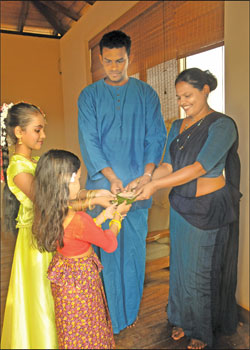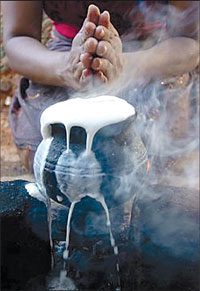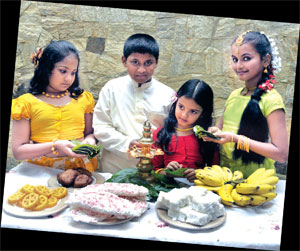|
Sinhala and Hindu New Year:
Traditional customs and rituals
The month of Bak - (April) ushers in a festive mood with the sweet
melody of the koel and the aroma of traditional sweetmeats filling the
air. It is the time to celebrate once again as the movement of the Sun
from the Meena Rashi (House of Pisces) to the Mesha Rashi (House of
Aries) in the celestial sphere marks the dawn of the Sinhala and Hindu
New Year. However, unlike the Western celebration of the new year at
midnight on December 31, the Sinhala and Hindu New Year begins at a time
determined by astrological signs.
 New Year is a solar festival commencing with the entry of the Sun to
zodiac of Aries. What is significant is that the ending of the old year,
and the beginning of the new year occur several hours apart from one
another is aptly referred to as the neutral period or nonagathe. Like
all the traditional activities connected with the New Year, the span of
time between the old and the New Year too is determined by the
astrologers. During nonagathe people devote their time in performing
religious practices. It is for this reason it is also called “Punya
Kale” when people stop all their activities, and visit the temple to
accrue merit and get their reserve from bhikkus. The date upon which the
New Year occurs, while determined by astrological signs, also tends to
coincide with the end of the harvest season . New Year is a solar festival commencing with the entry of the Sun to
zodiac of Aries. What is significant is that the ending of the old year,
and the beginning of the new year occur several hours apart from one
another is aptly referred to as the neutral period or nonagathe. Like
all the traditional activities connected with the New Year, the span of
time between the old and the New Year too is determined by the
astrologers. During nonagathe people devote their time in performing
religious practices. It is for this reason it is also called “Punya
Kale” when people stop all their activities, and visit the temple to
accrue merit and get their reserve from bhikkus. The date upon which the
New Year occurs, while determined by astrological signs, also tends to
coincide with the end of the harvest season .

With only a few more days for the dawn of the New Year , let’s check
out some interesting facts about the cultural traditions and customs
observed during this season. A variety of rituals such as lighting the
fire, making kiribath, (milk rice) entering into the first business
transaction and partaking of food are carefully determined by
astrological calculations .
The New Year Festival which has been celebrated from the times of the
great kings has today become an important national holiday for both the
cultures ; the Sinhalese Buddhists and the Tamil Hindus of Sri Lanka.
And one can see clearly that it is an ideal platform for national unity
as people of both nationalities welcome the New Year with joyful
celebrations with peace and joy in their hearts .A sense of goodwill and
friendship can be seen not only among relations and friends during the
festival time but also among the two communities.
The temple, kovil and the hearth play a key role in the many rituals
and traditions observed during the New Year. There is a belief both in
India and in Sri Lanka that at the New Year a new deity called“Avurudu
Kumaraya” took charge of nature. In some parts of Sri Lanka, they make
an altar with tender coconut palms for this deity. In other areas
specially in the South a lamp is lit for the Avurudu Kumaraya.
The rituals performed by the Hindu Tamils are similar to the rituals
followed by the Sinhalese to a great extent.Just like the Sinhala
community the Hindus too prepare and decorate the household before
the New Year. Saffron water is sprinkled after dusting and cleaning
is complete for further cleansing. The front area of the house is
especially cleaned to draw ‘kolam,’ which is a decorative design, done
using scraped coconut or white rice flour. The drawing of kolam is not
only for decorative purposes, but is drawn to make maximum use out of
articles of waste.
 Rituals connected with the festival generally commence with bathing
on the last day of the old year (Parana Avurudda) and viewing the moon
on the same night. The pealing of the bell in the village temple
accompanied with the beating of drums (Hewisi) make the people aware of
the times to perform different rituals.The day before the New Year, the
Hindus apply Maruthu Neer, an oil made, using nine herbal leaves on the
heads of the family members with the blessings of a priest. After
this they bathe in water boiled along with herbal leaves, selected
flowers, milk and saffron. Rituals connected with the festival generally commence with bathing
on the last day of the old year (Parana Avurudda) and viewing the moon
on the same night. The pealing of the bell in the village temple
accompanied with the beating of drums (Hewisi) make the people aware of
the times to perform different rituals.The day before the New Year, the
Hindus apply Maruthu Neer, an oil made, using nine herbal leaves on the
heads of the family members with the blessings of a priest. After
this they bathe in water boiled along with herbal leaves, selected
flowers, milk and saffron.
The Tamil community too gives a special place for their religion as
they go to the kovil before the auspicious time arrives for other
rituals in order to receive the blessing from the priest for the coming
New Year. Very often the rituals are carried out to the T mostly in the
villages as those living in populace cities have various constrains to
observe them.
In the villages even the preparation of the hearth is a great
ritual.It is made on the day of the New Year facing the correct
direction at the auspicious time. It is customary to use a new pot to
prepare the milk-rice (kiribath) and the fire is lit by the housewife.

Prior to this, milk is boiled in a newly earthen pot symbolising
prosperity whenthe milk spills over from all sides of the pot.Another
meal is cooked along with a curry “hath maluwa” that has seven different
flavours which is considered asa delicacy prepared during New Year time.
Other sweetmeats specially prepared for the festive season are made in
advance to serve the visitors who drop in.In the Hindu households too
the housewife plays a major role just like in the Sinhala ritual system
.The head of the household prepares the “mangala kumbam,” which is a pot
with five mango leaves and a coconut. Entering into the first
transaction of the year takes place with the head of the family starting
work signifying his occupation at the auspicious time. Generally if his
occupation is farming he will cut a portion of the land.
When the time to participate in the traditional meal dawns the entire
family sits down to eat at the auspicious time. Many people gift new
clothes and food to the poor soon after the meal.
The custom of offering betel to parents and elders demonstrate the
act of paying gratitude. The children in turn receive blessings from
parents.
During the days of the Kandyan Kingdom,the anointing of oils and Nanu
(herbal mixture) was done before taking the ceremonial bath. This was a
feature during the new year, showing the patronage of the Kings. The
anointing ceremony was planned as a religious ceremony by the royal
Nekath Mohottala, who would directly supervise it in accordance with his
instructions.
 The oils as well as nanu or the herbal mixture for applying on the
head before taking a bath in the new year was prepared by the royal
physician during the time of the kings. The oils as well as nanu or the herbal mixture for applying on the
head before taking a bath in the new year was prepared by the royal
physician during the time of the kings.
The preparation of oils and the herbal mixture are done by extracting
the juices from herbal leaves, flowers and fruits(seeds).
Once all the rituals are are done, it is time to celebrate with
family and friends serving the traditional food such as kaung (small oil
cake) and kokis (crisp and light sweetmeat),
There is great celebrations everywhere. What is noteworthy is that
the culture and rituals performed by the Tamil community bear many
similarities to the traditions adopted by the Sinhalese community.

There is now a general consensus in Sri Lanka to treat New Year as a
national festival. Its unique features could be made use of to promote
friendship and mutual understanding among people.
So, let’s take into consideration the significance of the festival
and learn more about the traditional customs and rituals practised by
both communities during the New Year festival. This would help us to
understand each other better and foster peace and harmony among the
people.
[Fast facts]
* Sinhala Avurudda dawns when the Sun moves from Meena Rashi to Mesha
Rashi completing a cycle of a twelve-month period.The transition time
known as “Sankranthi” takes place on April 13 or 14.
* The Sinhala Aluth Avurudda was celebrated in the Kandyan Kingdom as
a national festival under the patronage of the kings.This was done in
keeping with the rituals. The Sinhalese have celebrated New Year from
time immemorial.
* As in the past, even today astrologers work out auspicious times (Nekath)
to perform the rituals in order to bring about prosperity and happiness
to the people and country.
* The Tamil Hindus greet each other saying“puththandu nalvalththukal,”
(Happy New Year)
* People visit the temple during the time of “Sankranthi” the
transitional period when they believe that there are no auspicious times
(Nekath) to engage themselves in different tasks.This time is called
“Nonagathe”
* The applying of Nanu is done only on Wednesday because it is on
that day “Nanumuraya” is performed at Sri Dalada Maligawa and also at
four devales in Kandy. Nanumuraya is meant for bathing the deities in
the far off devales. This is performed in a symbolic manner to bathe the
four guardian deities of Lanka. |

